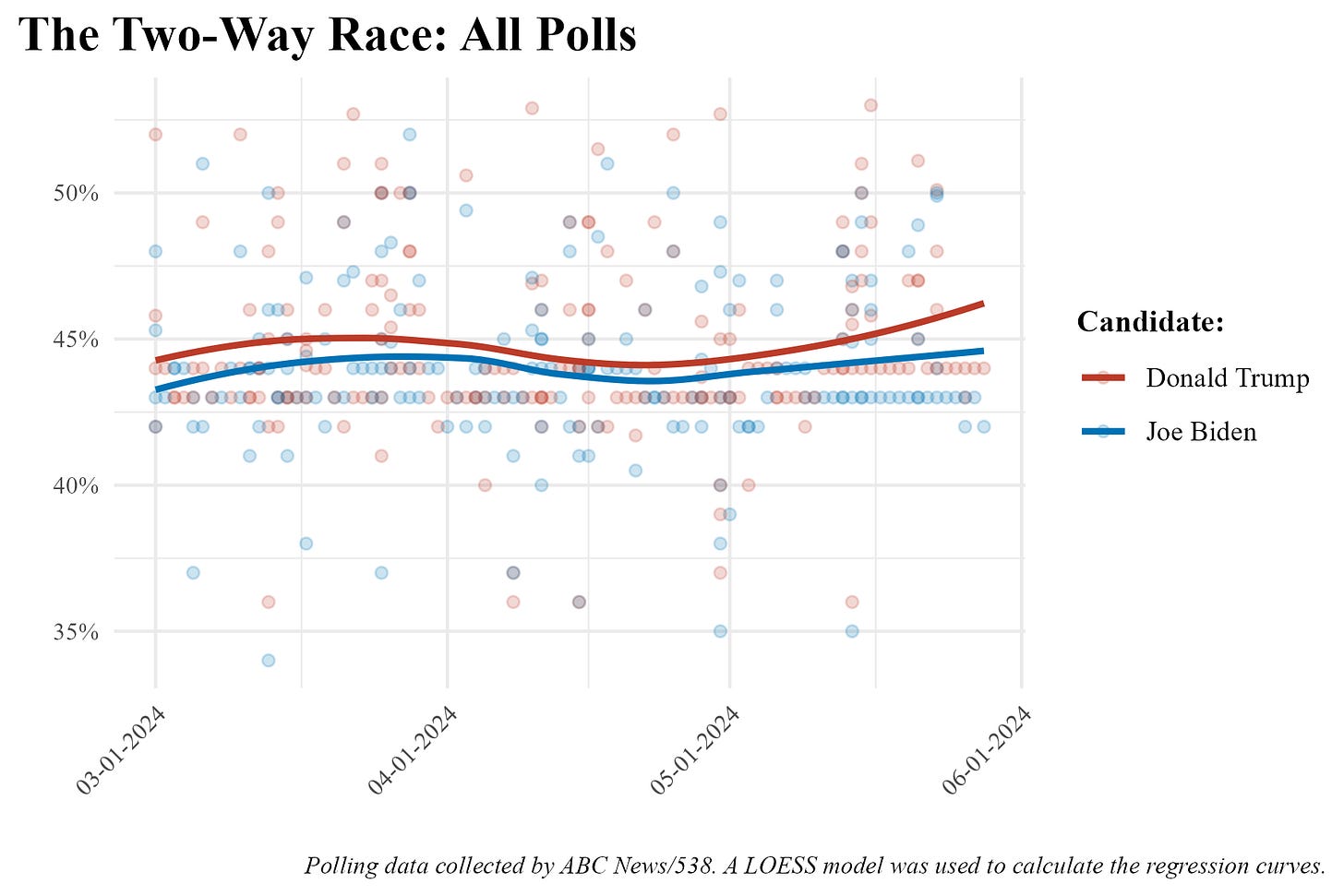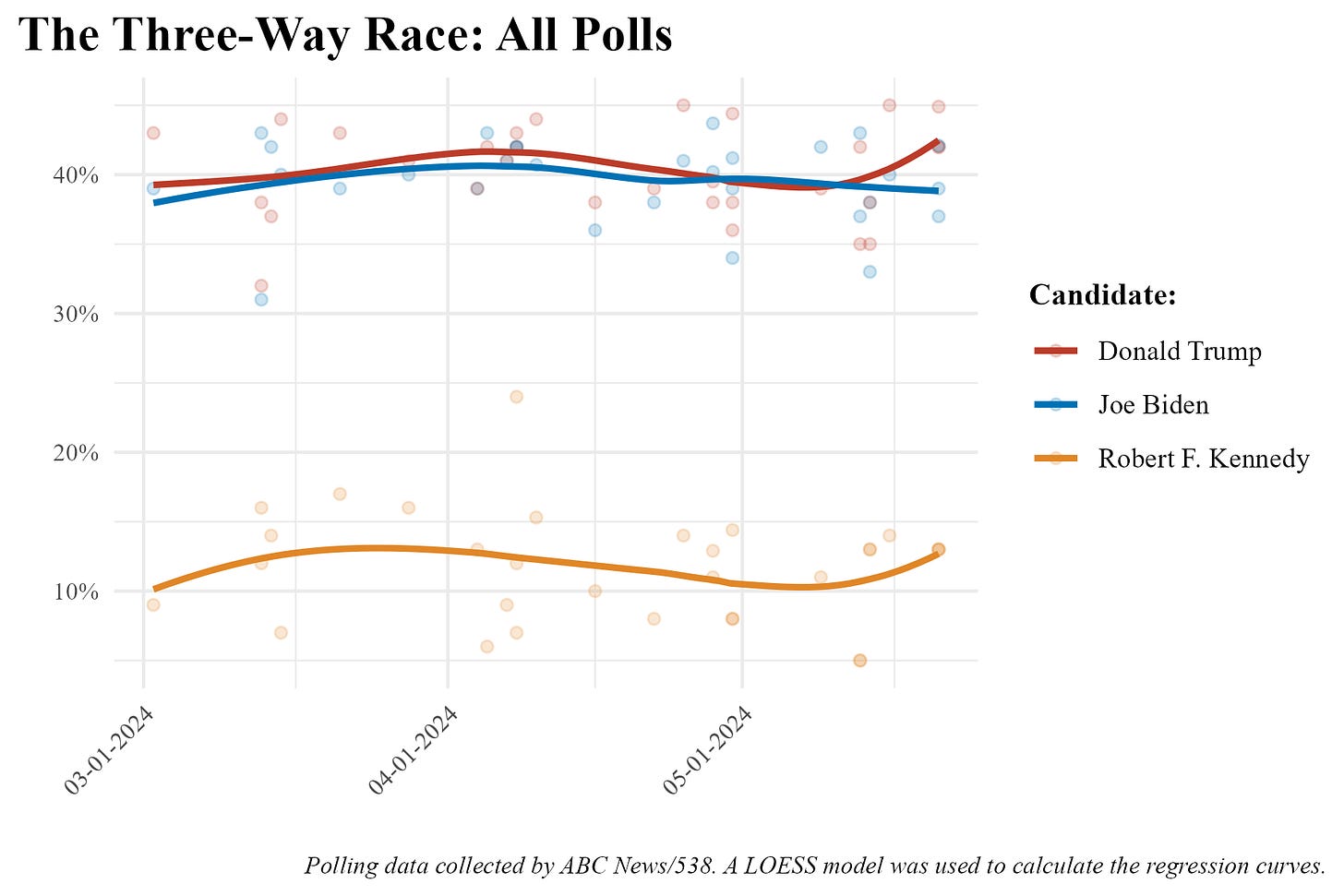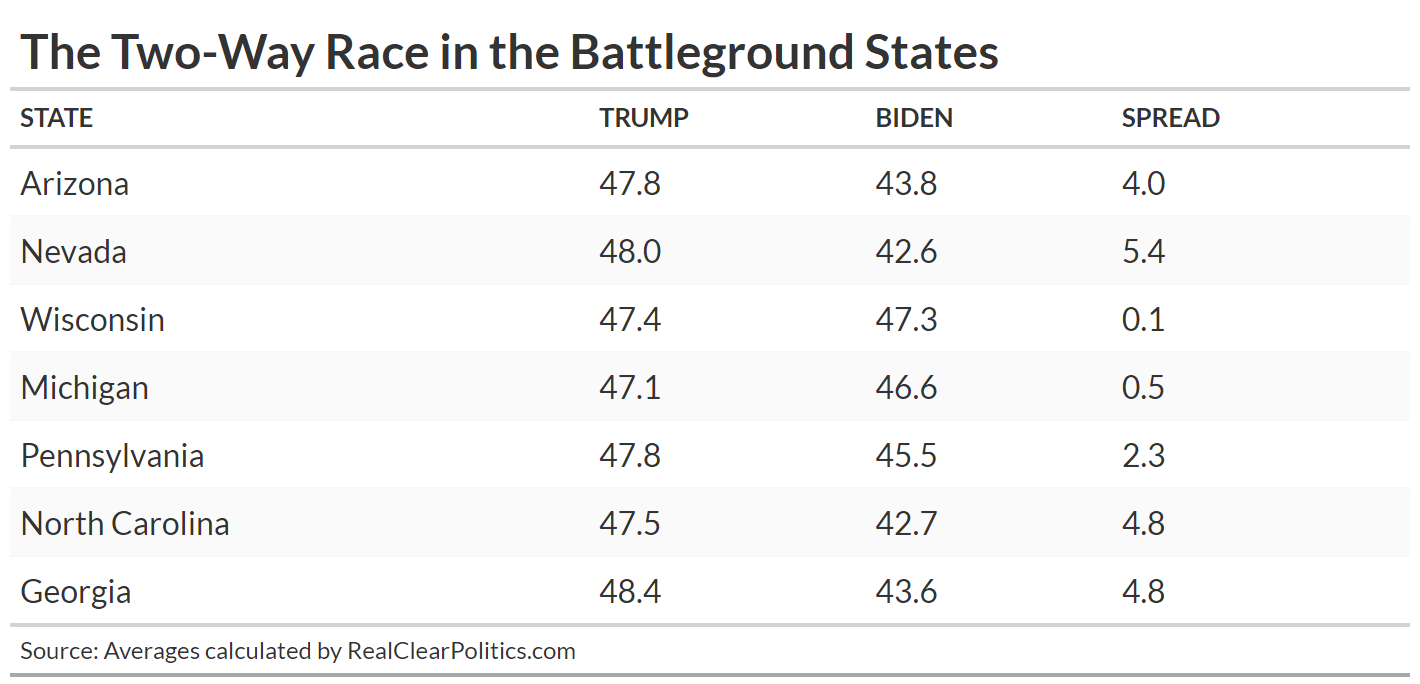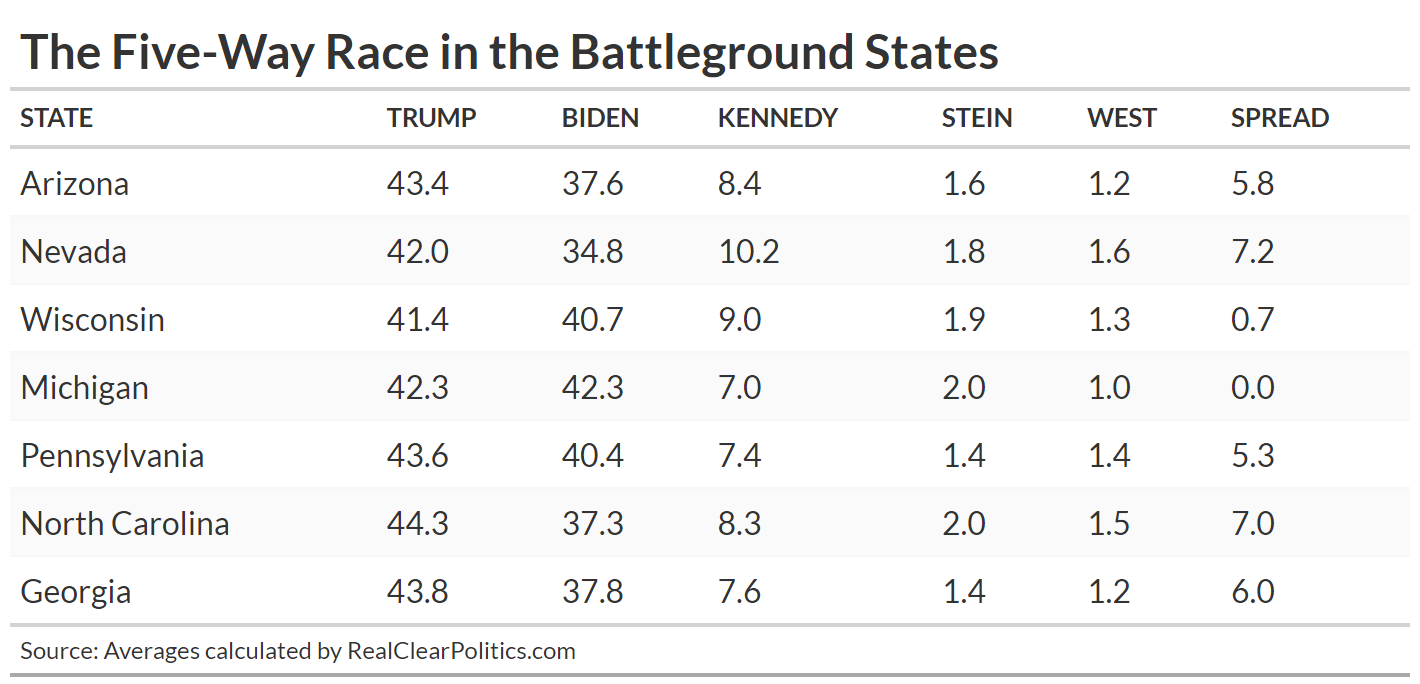The State of the Race: Analyzing the National and State Polls Before Trump's Guilty Verdict
I'm back! Finding time to write in the past few weeks was challenging due to all the craziness associated with the end of my semester.
Will former President Donald Trump’s guilty verdict in the Manhattan case affect the dynamics of the presidential race? In this post, I will review the national surveys up to May 30, 2024. I will also analyze the polls in the battleground states. These findings will help us assess in a future post whether the verdict will impact Trump’s support and his favorability ratings.
In addition, this post will consider whether the Biden campaign has been running on “false hope,” as suggested by Isaac Chotiner of The New Yorker. In his article, Chotiner interviews Simon Rosenberg, a Democratic strategist who gained recognition during the 2022 midterm elections. Rosenberg has since argued that the polls underestimated support for Democratic candidates for federal offices.
If the polls were wrong then, could they be wrong now? This is an intriguing question. Rosenberg argued that in 2022, surveys funded by various Republican organizations skewed polling averages to support their “red wave narrative.” By ignoring these polls and focusing on “independent polling,” he noted that the election appeared close and competitive. While Rosenberg is not dismissing polling altogether, his proposed methodology is slippery. His opinions suggest that some pollsters might be conducting surveys to mislead the public.
Putting Rosenberg’s views aside, multiple studies have shown that the 2022 polls were very reliable. For instance, The Pew Research Center found that pollsters, learning from the errors of 2016 and 2020, adopted new surveying methodologies, such as probability-based panels and online opt-in samples, which enhanced the accuracy of the polls. Nathaniel Rakich from FiveThirtyEight analyzed the performance of pollsters in 2022, and these findings have informed the news site’s “pollster ratings,” which also consider the polling firms’ “historical accuracy and transparency.”
With less than six months until election day, let’s take a closer look at the state of the two-way race. The first graph uses a LOESS regression to aggregate all the polls archived by FiveThirtyEight conducted between March 1, 2024, and May 30, 2024.
As noted in earlier posts, Trump has maintained a small lead in this election cycle. Unlike in 2020, when Biden led early in the race, he has been trailing Trump in 2024.
The next graph compares polls that survey “registered voters” (RVs) to those that focus on “likely voters” (LVs). This graph excludes polls that do not ask respondents about their voting intentions. At the end of April 2024, an ABC News/Ipsos poll found that while Biden trailed Trump among RVs, he was slightly ahead among LVs. Many observers have explained Biden’s underperformance in recent months by suggesting that his prospects will improve as pollsters transition from RV models to LV models.
Using a LOESS regression, the graph shows that Trump narrowly leads in both samples, raising important questions about Biden’s candidacy.
In a tight race, third-party candidates can significantly affect the outcome of the election. The following graph takes a closer look at the three-way race between Biden, Trump, and Robert F. Kennedy, Jr., aggregating all polls conducted between March 1, 2024, and May 30, 2024.
As before, the following graph compares the LVs and RVs models of the archived surveys.
These graphs illustrate a more competitive race. While it is unclear whether Kennedy’s candidacy benefits Trump or Biden, it is likely to act as a spoiler. This adds another layer of uncertainty and complexity to an already tightly contested election.
Here is the current state of the race between Trump, Biden, and other third-party candidates. It is important to note that this graph aggregates all polls and does not include the Libertarian Party’s candidate, Chase Oliver, who secured the nomination on May 26, 2024.
While a few polls survey LVs in the five-way race within FiveThirtyEight’s archive, I include the following graph for consistency’s sake.
Similar to the other graphs, Trump holds a slight lead over Biden in the national polls. However, since the winner is determined by the Electoral College rather than the popular vote, let us analyze the RealClearPolitics averages for both the two-way and five-way races in this year’s battleground states as of May 30, 2024.
The findings from these tables underscore Trump’s consistent leads in most of these states. More concerning for the Biden campaign is the notable decline in support for the incumbent president as voters are presented with more options.
FiveThirtyEight’s methodology for calculating averages in these battleground states differs from that of RealClearPolitics. The table below presents the 538 averages as of May 30, 2024.
If we use FiveThirtyEight’s averages, Trump would be the clear winner if the election was held before his guilty verdict.
As noted in my post of April 17, 2024, in 2020 Biden secured a decisive victory by capturing 306 electoral votes, winning key battleground states such as Pennsylvania, Wisconsin, and Michigan, all of which had previously supported Trump in 2016. Additionally, the Biden campaign successfully turned the tables in traditionally Republican-leaning Georgia and Arizona, signaling a noteworthy realignment in the electoral landscape.
It appears that Trump holds comfortable leads in Arizona, Nevada, Georgia, and North Carolina. The election is closer in Wisconsin, Pennsylvania, and Michigan. Interestingly, Biden performs better in battleground states with larger white voter populations, while Trump is stronger in the more diverse states.
Here’s an Electoral College vote map depicting the race. Due to close margins, Wisconsin, Michigan, and Pennsylvania are labeled as “toss-up” states. However, current polling indicates a tighter race in New Hampshire, Minnesota, and Virginia, which Biden won comfortably in 2020. Therefore, these states are categorized as “Leans Biden.”
As of May 30, 2024, Trump has secured 214 electoral college votes compared to Biden’s 208. An additional 54 votes lean towards Trump, while 18 lean towards Biden. With 44 electoral votes up for grabs, Trump currently leads Biden in the Electoral College, with a tally of 268 to 236.
In conclusion, the central question remains: Will the guilty verdict against former President Donald Trump in the Manhattan criminal case influence the dynamics of the presidential race? Throughout this post, we have examined national surveys up to May 30, 2024, and analyzed polling data from battleground states. These insights provide a solid foundation for evaluating whether the verdict will impact Trump’s support and favorability ratings in future posts. As the election draws nearer and new developments emerge, it will be vital to monitor how these factors shape the election’s trajectory. One thing is evident, however: with 156 days until the election, Biden lags behind Trump in both national surveys and crucial battleground states.











